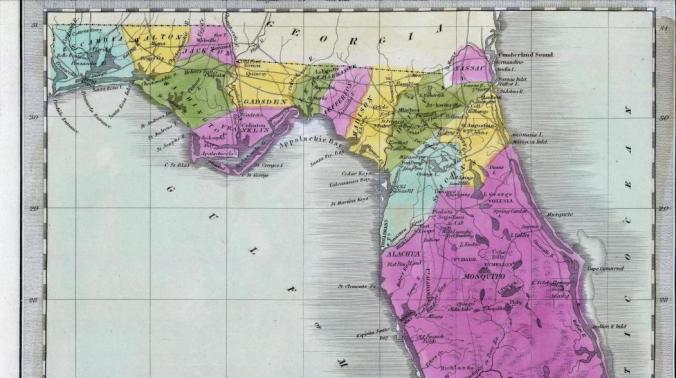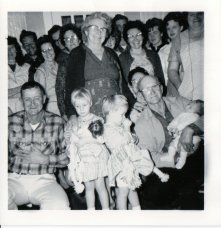In the last post, we left Oak Grove at the end of 1830 with approximately 30 families having settled along the Yellow River in what was then Walton Co, FL. By 1839 the community of Barrow’s Ferry/Oak Grove had grown a bit, the area filling out on both sides of the river. And many of these people wanted the river that flowed along their communities to be more navigable. If we cross-reference this 1839-petition to Congress with the 1840 Walton County census we get a nice “neighborhood” of people with clear upper and lower boundaries on the census that likely encompass the community members of Oak Grove and possibly at least some of Almirante’s residents. As with the previous assessment of residents of Oak Grove, it is quite possible this excludes a few families but likely does get at the core of the community in 1839/1840.
We now have the fifty families that some of us heard settled Oak Grove. The population has grown a bit from a total of 223 in 1830 to a total of 377 in 1840. That’s a pretty good growth rate in one decade (41%). The ratios of population demographics stayed pretty consistent. White Males were 41% of the population in 1830 and 45% in 1840. White Females were 34% of the population in 1830 and 36% in 1840. Enslaved Males were 13% in 1830 and 9% in 1840. Enslaved Females were 9% in 1830 and 8% in 1840. And finally Free Male Persons of Color remained at 1% of the population and Free Female Persons of Color remained at 2% of the population. The enslaved population had grown slightly in the ensuing decade but not nearly as quickly as the white population, hence the drop in percentages for enslaved persons to the total population of the area.

Jeremiah Greenleaf, partial map of Florida, 1840

Note Yellow River called “Red Clay River”
There is a couple of interesting observations in these families when compared with the 1840 initial membership list from Yellow River Baptist Church that may give us some insight into this community in its early stages. In 1830 there was a Rachel Devereaux in the census that was the head of a household of free persons of color. She may be the widow of Samuel A. Devereaux/Debrow who died in Florida in 1826. She is believed to be a Muskogee/Creek Indian. There are three women who were members of Yellow River Baptist Church in 1840 with the surname of Devereaux (all listed with white members); Fasiny (as spelled in the record), Elizabeth, and Sally or another Fasiny (Sally has a line drawn through it and Fasiny is written in the margin). Later in 1859, there are several more females with the surname Devereaux; Frannah, Levinah, Eliza, and Sarah. No Devereaux men are listed as members of the church.
In 1840 there are two households that were composed of all Free Persons of Color. Betty Allen was head of household with 5 younger persons in the household. I have not been able to find any other information on this family to determine if they too were Indian or a household of free black persons. The second Free Person of Color in 1840 is particularly fascinating and deserves more investigation. His name was Free George and he is listed as a “colored” member of the church in the late 1850s (both the census and the church membership list records his given name as Free). There is one woman with the same surname listed as a “colored” member that may be his wife. Her name was Rodah. In the 1840 census, the household is just Free and a woman of the same age range, likely his wife. Free George is living next door to one of my ancestors in 1840, a level of integration of the community that would increase after the War for Southern Independence (Civil War, War Between the States) and remain relatively stable until the 1920s. But that’s another story for another time. It might be good to point out here that an earlier set of posts (First and Second post) discussed the extraordinarily high numbers of men who were members of Yellow River Baptist Church that served with the Union in Pensacola during the war. There is much yet we do not know about this early settler community in the Northwest Florida panhandle but I’ve discovered or reaffirmed what would appear to be the pillars of the community: 1) relationships/family, 2) yeoman farming, 3) bootlegging, 4) the Masonic lodge, and the 5) Yellow River Baptist Church. At this point, I’m not yet putting them in order of importance, though if longevity is a factor the church and relationships are one and two and the ever illusive bootlegging is an unknown!
Here is a list of the likely Oak Grove community members in 1840:
- Allen, Betty
- Baggett, Edmond (member of the church)
- Baggett, Lewis
- Baggett, Nicholas (member of the church)
- Baker, Starkes
- Barrow, John (Jr.)(member of the church)
- Barrow, R. N.(Reuben)(member of the church)
- Barrow, Richmond (member of the church)
- Barrow, Thomas
- Busby, Zachariah T.
- Campbell, Peter
- Carpenter, John W.
- Cawthorn, William
- Clary, John D. (member of the church)
- Dulany, Thomas
- Eddings, J. H.
- Fuqua, Absalom
- Fuqua, R. R. (member of the church)
- Gartman, David (member of the church)
- Gaskins, Wright
- George, Free (member of the church)
- Gordon, Elizabeth (member of the church)
- Harrelson, John
- Harrelson, Jonathan
- Hart, Reuben (Jr.)(member of the church)
- Horne, Joab
- Johnson, Starling
- Jones, Charles
- Leger, Moses S.
- McCaskill, Daniel
- McDavid, John
- McDowell, John
- McDowell, William
- Morrison, Norman
- Richbourg, John (member of the church)
- Robertson, Green (member of the church)
- Robertson, John (member of the church)
- Senterfitt, Jesse (member of the church)
- Senterfitt, Stephen (member of the church)
- Steagall, Archibald
- Steagall, McMillan
- Steagall, Reuben (member of the church)
- Steele, Eliza (member of the church)
- Stevenson, John
- Stokes, Absalom
- Ward, David
- Ward, Elijah
- Ward, William
- Wilkinson, Daniel
- Wilkinson, William J.
- Wood, Freeman
I would like to deviate at this point from talking about Oak Grove to talking about why as genealogists we should think about the communities our ancestors lived in and how those communities would have been, and could have been, influences in our ancestors’ lives and possibly what was passed down to each of us as their descendants. Many family historians focus just on collecting names, gathering them up wherever they find them. I’ve had folks share their databases with me that was truly mind-boggling with one person having children in five or six distant locations across several states and not in geographical logical order but back and forth in a relatively short period of time! Just the other day I found two records at Ancestry where the father and son were born in the same year. Now there’s a trick!
Some do make an effort to research both sides of each generation but some just focus on the male line, like that would be the only place they would have inherited genes and behaviors, great stories, or famous or infamous ancestors. And very few make an effort to look at the surrounding families and whether they share characteristics (name origins), place of birth, or may have relationships by marriage. I’ve found that broadening my view of the places my ancestors lived, and the people they interacted with daily, gives me a much richer view and understanding of who they were and sometimes puts into context some seemingly inexplicable decision they made. Try it the next time you hit a brick wall and you are finding yourself feeling a bit frustrated with genealogy. It may refresh your efforts and give you new leads to follow.
One final request or suggestion. If your ancestor had enslaved persons in their household make an effort to document that through the census, deeds of sell and family stories. Try to start treating the often limited information available in these records not as objects but as people. You just might find someone descended from one of these enslaved persons in your ancestor’s household who is as avid a genealogist as you and can provide you with information from a different perspective that will again enrich your research. Then maybe you can return that favor. I had that happen to me not too long again and together we were able to put some meat on a partial story we had both been told about our separate ancestors from two very different perspectives. Oh, and we also discovered we have a common ancestor (through DNA), though we aren’t sure yet whether it was the common ancestor, or one of the sons, that made that a fact.

The Motley Crew
I think for the next several posts I’m going to deviate from this chronology of Oak Grove and share some of my favorite family stories and pictures, some told to me by family, some that I was a part of and some I’ve put together with research. My reason is that my maternal cousins and I are having our second large family reunion gathering (as old folks) in November. November was my maternal grandparents’ wedding anniversary so that was when everyone tried to make it home to eat, laugh, eat some more, play, eat some more and generally have fun (and sometimes regret eating some more). The “Motley Crew” to the right are some of the older members of my generation. We are now the “senior” members of the family (oh no, tell me it ain’t so!). Names are withheld in this photo to protect the guilty!

Family Reunion early 1960s
This year on November 12th we have expanded our reunion to any descendant of Richmond and Martha Senterfitt Barrow and/or any descendant of William Franklin and Mary Malissa Hart King. If you fit either category, we would love for you to join us at the Blackman Community Center in Blackman, Florida on November 12th from 10 a.m. to 2 p.m. Bring one or more covered dishes and/or drinks, because we still do the eating thing (and the laughing thing). And bring any items you would like to share with the rest of us; pictures, stories, handmade items, etc. On the posting for November 21st, we will come back to Oak Grove as the nation approaches the War in 1861.
‘Till next time.
Pingback: Northwest Florida Early Pioneers: James Millard and Lydia Olive Gaskin(s) – Northwest Florida History
Pingback: Approaching the Coming Crisis: 1840-1860 in the NW Florida community of Oak Grove – Northwest Florida History
Pingback: Clyde Barrow’s Connection to Northwest Florida – Northwest Florida History
Pingback: Oak Grove in Okaloosa County, FL: It’s Importance & Development in the History of the FL Panhandle | Northwest Florida History & Genealogy
Pingback: Getting to Know a Community from the Past | Northwest Florida History & Genealogy
Pingback: Updates and Links to My Posts on Oak Grove in Okaloosa County, FL | Northwest Florida History & Genealogy
Rachel Devereaux is my gggg- grandmother. I have for years tried to find out more about her, specially her last name at her birth and prior to her marriage to Samuel. Ancestry proclaims her name as Barron but I have no proof of that. Since Barrow is significant to her being in several locations I have always wondered if Barrow could have been her name instead of Barron. Interestingly, in DNA on Ancestry, I do share DNA with some members of the ancestry line of Barron and Murray (Joseph Barron’s wife) and so I more puzzlement continues. Thanks for your info on NW Florida and the Yellow River Church.
LikeLike